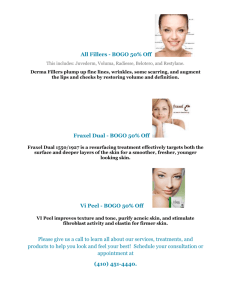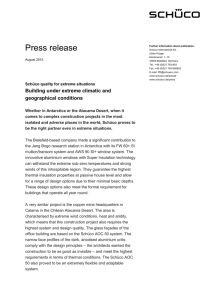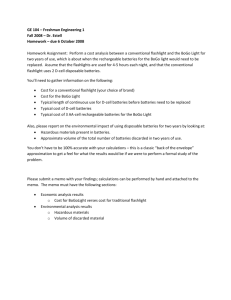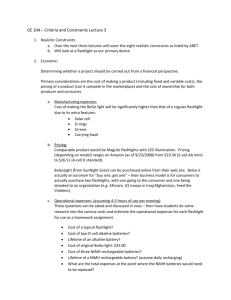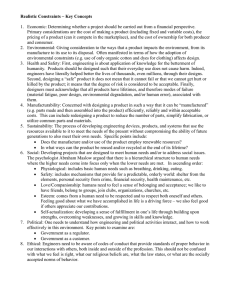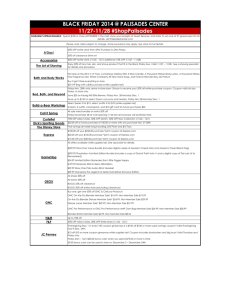Research Journal of Applied Sciences, Engineering and Technology 5(9): 2740-2747,... ISSN: 2040-7459; e-ISSN: 2040-7467
advertisement
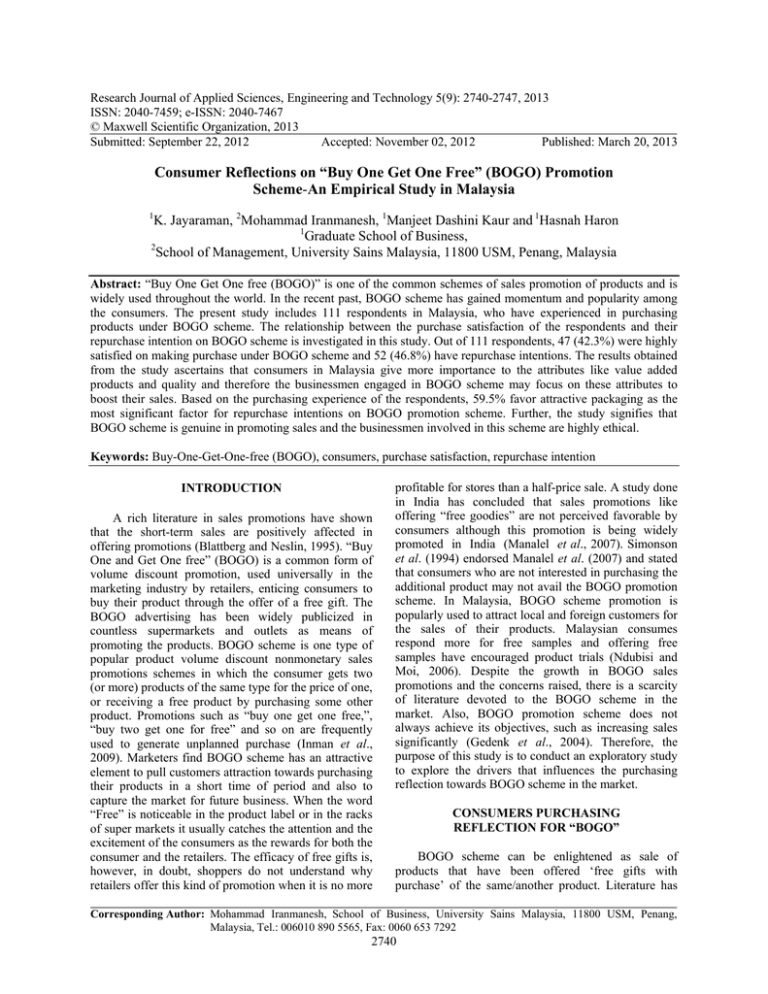
Research Journal of Applied Sciences, Engineering and Technology 5(9): 2740-2747, 2013 ISSN: 2040-7459; e-ISSN: 2040-7467 © Maxwell Scientific Organization, 2013 Submitted: September 22, 2012 Accepted: November 02, 2012 Published: March 20, 2013 Consumer Reflections on “Buy One Get One Free” (BOGO) Promotion Scheme-An Empirical Study in Malaysia 1 K. Jayaraman, 2Mohammad Iranmanesh, 1Manjeet Dashini Kaur and 1Hasnah Haron 1 Graduate School of Business, 2 School of Management, University Sains Malaysia, 11800 USM, Penang, Malaysia Abstract: “Buy One Get One free (BOGO)” is one of the common schemes of sales promotion of products and is widely used throughout the world. In the recent past, BOGO scheme has gained momentum and popularity among the consumers. The present study includes 111 respondents in Malaysia, who have experienced in purchasing products under BOGO scheme. The relationship between the purchase satisfaction of the respondents and their repurchase intention on BOGO scheme is investigated in this study. Out of 111 respondents, 47 (42.3%) were highly satisfied on making purchase under BOGO scheme and 52 (46.8%) have repurchase intentions. The results obtained from the study ascertains that consumers in Malaysia give more importance to the attributes like value added products and quality and therefore the businessmen engaged in BOGO scheme may focus on these attributes to boost their sales. Based on the purchasing experience of the respondents, 59.5% favor attractive packaging as the most significant factor for repurchase intentions on BOGO promotion scheme. Further, the study signifies that BOGO scheme is genuine in promoting sales and the businessmen involved in this scheme are highly ethical. Keywords: Buy-One-Get-One-free (BOGO), consumers, purchase satisfaction, repurchase intention INTRODUCTION A rich literature in sales promotions have shown that the short-term sales are positively affected in offering promotions (Blattberg and Neslin, 1995). “Buy One and Get One free” (BOGO) is a common form of volume discount promotion, used universally in the marketing industry by retailers, enticing consumers to buy their product through the offer of a free gift. The BOGO advertising has been widely publicized in countless supermarkets and outlets as means of promoting the products. BOGO scheme is one type of popular product volume discount nonmonetary sales promotions schemes in which the consumer gets two (or more) products of the same type for the price of one, or receiving a free product by purchasing some other product. Promotions such as “buy one get one free,”, “buy two get one for free” and so on are frequently used to generate unplanned purchase (Inman et al., 2009). Marketers find BOGO scheme has an attractive element to pull customers attraction towards purchasing their products in a short time of period and also to capture the market for future business. When the word “Free” is noticeable in the product label or in the racks of super markets it usually catches the attention and the excitement of the consumers as the rewards for both the consumer and the retailers. The efficacy of free gifts is, however, in doubt, shoppers do not understand why retailers offer this kind of promotion when it is no more profitable for stores than a half-price sale. A study done in India has concluded that sales promotions like offering “free goodies” are not perceived favorable by consumers although this promotion is being widely promoted in India (Manalel et al., 2007). Simonson et al. (1994) endorsed Manalel et al. (2007) and stated that consumers who are not interested in purchasing the additional product may not avail the BOGO promotion scheme. In Malaysia, BOGO scheme promotion is popularly used to attract local and foreign customers for the sales of their products. Malaysian consumes respond more for free samples and offering free samples have encouraged product trials (Ndubisi and Moi, 2006). Despite the growth in BOGO sales promotions and the concerns raised, there is a scarcity of literature devoted to the BOGO scheme in the market. Also, BOGO promotion scheme does not always achieve its objectives, such as increasing sales significantly (Gedenk et al., 2004). Therefore, the purpose of this study is to conduct an exploratory study to explore the drivers that influences the purchasing reflection towards BOGO scheme in the market. CONSUMERS PURCHASING REFLECTION FOR “BOGO” BOGO scheme can be enlightened as sale of products that have been offered ‘free gifts with purchase’ of the same/another product. Literature has Corresponding Author: Mohammad Iranmanesh, School of Business, University Sains Malaysia, 11800 USM, Penang, Malaysia, Tel.: 006010 890 5565, Fax: 0060 653 7292 2740 Res. J. Appl. Sci. Eng. Technol., 5(9): 2740-2747, 2013 Table 1: Literature on discount promotion schemes Type Technique Description Monetary Price cut Smart saver! promotion Save 35¢ with this coupon Redeem at checkout Weekly special! Up to 70% discount Free product Value pack! (BOGO scheme) 15% more product free Non-monetary promotion Free gift (BOGO scheme) Sweepstakes Type of products sold High priced product (TV) Non-stock-up (yogurt) Low consumption level (yogurt) high utilitarian and low hedonic product (microwave) Low priced product (milk) Stock-up (powdered milk) High consumption level (mineral Special offer! water) Buy one, get another at half High utilitarian and medium price! hedonic products (food) Buy this cell phone and get Low priced product (milk) free 2 GB memory card Stock-up (powdered milk) High consumption level (mineral Free video tape rental! water) Medium utilitarian and high hedonic products (cell phone) Have fun! Low utilitarian and high hedonic Free tickets to watch favorite products (game) Major league baseball team! revealed that advertising of BOGO scheme is a successful promotional technique as the additional product is provided free of charge with the purchase of original product. This has eventually, persuaded consumers to purchase the product and encouraging consumers to purchase additional as well. Many questions are raised in the business world on the purchasing behavior towards the BOGO scheme. Regardless of this unanswered question, BOGO scheme remains widely advertized and attracting many consumers globally to purchase through the scheme. Many consumers have intention to purchase products with quality but with lowest price. If the perceived values of the product are greater than cost of the product, it is observed that consumers will purchase the product (Yee and Sidek, 2008). A large number of studies show that discount offers can have positive effects on consumer perceptions in terms of the value associated with the offer (Darke and Dahl, 2003; Inman et al., 1997; Urbany et al., 1988). Compeau and Grewal (1998) suggested that negative price-quality inferences are likely to moderate positive discount framing effects on deal value. This can occur in two ways. Discounts can lead to more negative consumer perceptions by undermining the perceived quality of the discounted item (Scott and Yalch, 1980; Tybout and Scott, 1983) and lowering the probability of future purchases (Dodson et al., 1978; Doob et al., 1969). Raghubir and Corfman (1999) stated that the quality inference of a product is most likely to matter when other companies in the industry do not promote. Free gift options such as BOGO scheme maintains quality perceptions and increase deal value. Thus, in order to overcome the problem that promotions undermine quality perceptions, free gift provides a feasible alternative. In addition, consumers may infer that getting a discount does not result in a lower selling price as marketers raise the initial price of the item, holding the selling Sources of type of products sold Gendall (2006) Sinha and Smith (2000) Li et al. (2007) Chandon et al. (2000) Gendall (2006) Sinha and Smith (2000) Li et al. (2007) Chandon et al. (2000) Gendall (2006) Sinha and Smith (2000) Li et al. (2007) Chandon et al. (2000) Chandon et al. (2000) price remains constant. In this case, getting a discount does not result in a lower selling price, which means there is simply no way that negative price-quality inferences could undermine the perceptions of value (Darke and Chung, 2005). As a promotional tactic, advertising serves as the most important tool in generating product awareness and stipulation of the mind of a potential consumer to take ultimate purchase choices (Ayanwak et al., 2005). BOGO scheme can be used effectively to advertise and gain sales for new product launched in the market. Consumers may repeat the purchase of single brands or change between few brands due to the perceived quality of the products sold (Yee and Sidek, 2008). Researchers have initiated that promotions, particularly price promotions have negative effect on brand equity (Mela et al., 1997). BOGO scheme itself is value added scheme since it provides a free product when the original product is purchased. Consumer purchase satisfaction is identified to contain a positive impact on market share and may be moderated by factors such as price sensitivity and perceived value (Magi, 2003). Consumer satisfaction is the post-purchase evaluation of a service offering (Oh, 2000). Marketers need to ensure that BOGO scheme is creating satisfaction among the consumers to make the scheme successful as a discount sales promotion and to create the repurchase interest from consumers. In Malaysia, the scheme is very popular and attracted the mass of consumers but no studies are available in the literature on the consumer’s preference of BOGO scheme and this has motivated the interest of the present study. The various promotion schemes adopted in the market to sell the products and to attract the consumers are listed in Table 1. Although, there are many promotion schemes for selling products listed in Table 1, Chandon et al. (2000) have pointed out that hedonic benefits and utilitarian benefits for consumers are high in BOGO promotion 2741 Res. J. Appl. Sci. Eng. Technol., 5(9): 2740-2747, 2013 scheme. Hence, the objective of the study is to investigate whether the consumers are interested in purchasing products under BOGO promotion scheme and the factors that influence the consumers to opt to purchase products under this scheme. RESEARCH METHODOLOGY The present study is conducted in Malaysia by distributing the questionnaire through hardcopy to SME/MNC company employees, food outlets, supermarkets and softcopy through online. The list of items in the questionnaire is provided in Table 2, For the purpose of gathering pertinent and reliable data, respondents who are full time university students, children below the age of 16 year, discount sales distributors, shop owners, marketers and sellers who have been practicing BOGO scheme were excluded for the study. A total of 111 respondents took part in the study and their responses were used for the statistical analysis. Out of 111 respondents, 66 (59.5%) were females and the remaining 40 (40.5%) were males. Majority of the respondents (39.6%) are earning the salary between the range from USD1000-USD 2000. Table 3 summaries the purchasing habits of respondents, their preference and experiences of Table 2: Constructs of the questionnaire items measured on a 5-point Likert scale Independent variables Sources C. Quality C1. Marketers cheat quality of products Raghubir and Corfman (1999), Scott and Yalch (1980) and Tybout and Scott (1983) C2. Satisfied with quality of products Darke and Chung (2005) C3. Products are of good quality Darke and Chung (2005) C4. Same as normal product quality Levin et al. (1998) C5. Sell cheap quality products Raghubir and Corfman (1999), Scott and Yalch (1980) and Tybout and Scoth (1983) C6. Old stocks are sold Barry (2009) D. Pricing D1. Product price sold at cheaper rate Wong and Yahyah (2008) D2. Price is reasonable Wong and Yahyah (2008) D3. Getting a good price deal Wong and Yahyah (2008) D4. Price is manipulated Lichtenstein and Bearden (1989) and Urbany et al. (1988) E. Advertising E1. Advertisements to attract customers Gilbert and Jackaria (2002) E2. Marketers achieve own profit by advertising Simpson (2006) E3. Good discount promotion strategy Self-construct but supported by face validation E4. Advertising to sell unsold stocks Barry (2009) F. Value added F1. Scheme is beneficial overall Compeau and Grewal (1998), Lobb (1997) and Darke and Dahl (2003) F2. Scheme brings value-quality Self-construct but supported by face validation F3. Scheme brings value-price Thaler (1985) F4. Scheme saves money Self-construct but supported by face validation F5. Scheme saves time and energy Lovelock and Wirtz (2004) Table 3: Purchasing habits of respondents Variable Purchase preference Purchasing experience of BOGO scheme Types of products purchased under BOGO scheme (multiple entries are possible) Influence of attractive packaging on BOGO scheme Category BOGO Discounted price Sample items Free coupons Up to 70% discount sales Up to 50% discount sales Roadside Big malls/supermarkets Sundry shops Airport/ferry terminals Bus stations Railway stations commuter stations Others Textile Food and drinks Shoes Chocolates Electrical goods Electronic goods Branded items Gifts articles Tourism products Yes No 2742 No. of respondents 33 23 4 2 37 12 1 90 3 11 3 1 2 56 42 20 36 10 8 8 12 13 66 45 (%) 29.7 20.7 3.6 1.8 33.3 10.8 0.9 81.1 2.7 9.9 2.7 0.9 1.8 50.5 37.8 18 32.4 9 7.2 7.2 10.8 11.7 59.5 40.5 Res. J. Appl. Sci. Eng. Technol., 5(9): 2740-2747, 2013 Fig. 1: Research framework purchasing on discount sales. The most popular discount schemes as per as the purchase preference of the respondents are concerned, up to 70% discount sales and BOGO scheme are rated in the first two places with 33.3 and 29.7%, respectively. According to the respondents purchase experience of BOGO scheme, big malls and supermarkets were ranked number one with 81.1%. The most common type of products purchased under the BOGO scheme is textiles (50.5%) followed by food and drinks (37.8%). It seems to be logical as these are the items that are widely promoted under the BOGO scheme in supermarkets and other malls. The respondents agreed that attractive packaging can sway them to be engrossed in purchasing products under BOGO scheme and this accounts for 59.5% of the sample. The study covers four independent variables namely quality, pricing, advertisement and Value added with one moderating variable (purchase satisfaction of n consumers) and one dependent variable (Repurchase intention on BOGO scheme). The research framework is depicted in Fig. 1. The independent variables are measured on a Likert scale 1-5, 1 stands for strongly disagree and 5 stands for strongly agree. The moderating variable namely purchase satisfaction of consumer is measured on an ordinal scale from 1-10, 1 being not satisfied and 10 being highly satisfied to make purchase through BOGO scheme. The dependent variable is measured again on an ordinal scale from 1-10, 1 being less likely to repurchase under BOGO scheme and 10 being most likely to repurchase. The study uses the management theory of loyalty model as a base for the research framework. Loyalty strategies are created having the suitable marketing mix namely product, price, place, promotions (McCarthy, 1971) to have the appropriate positioning in the minds of the targeted consumers in comparison to competitors. Customer value has the four selected marketing factors of the BOGO scheme namely quality, price, advertising and value added. These factors significantly contribute to the satisfaction of consumers on the products and services offered and eventually would lead to re-purchase interest of consumers. HYPOTHESES DEVELOPMENT Five hypotheses have been constructed in the study to determine the relationship between the independent variables and the repurchase intention (dependent variable) with purchase satisfaction of consumers as a moderating variable. The hypotheses are discussed below: Based on Yee and Sidek (2008), consumers may repeat the purchase of single brands or change between few brands due to the perceived quality of the products sold. As cited in Yang and Peterson (2004), some scholars hold up a positive direct effect of perceived quality on purchase intentions. Accordingly, this study hypothesizes that: H 1a : The better the quality of products sold under BOGO scheme will lead to repurchase intention of consumers. Gilbert and Jackaria (2002) specified that price bundles are designed to attract shoppers' attention and ultimately entice them to buy. Gendall (2006) indicates that monetary discount and volume discounts may be equivalent at discount level, they have different financial and physical implications for customers and they depend on price level of the product concerned. For low price items, volume discounting is more attractive than a monetary discount, therefore this study hypothesizes that: H 1b : The more the price of the products sold under BOGO scheme will lead to less likely for repurchase intention of consumers. Marketers advertize BOGO scheme to attract consumers to purchase the products. BOGO scheme can be used effectively to advertise and gain sales for new products to be launched in the market. Grewal et al. (2010) opinied that advertising can either decrease or increase customer satisfaction. Accordingly, this study hypothesizes that: 2743 Res. J. Appl. Sci. Eng. Technol., 5(9): 2740-2747, 2013 Table 4: Results of factor analysis for the independent variables Construct Items Quality-1 C1. Marketers cheat quality of products C5. Sell cheap quality products C6. Old stocks are sold Quality-2 C2. Satisfied with quality of products C3. Products are of good quality C4. Same as normal product quality Pricing D1. Product price sold at cheaper rate D2. Price is reasonable D3. Getting a good price deal Advertising E2. Marketers achieve own profit by advertising E4. Advertising to sell unsold stocks Value added F1. Scheme is beneficial overall F2. Scheme brings value-quality F3. Scheme brings value-price F4. Scheme saves money F5. Scheme saves time and energy KMO Bartlett’s test of sphericity Total variance explained Reliability (cronbach’s alpha) Factor loading 0.746 0.857 0.665 0.528 0.881 0.884 0.795 0.903 0.799 0.893 0.910 0.709 176.371, p<0.01 63% 0.678 0.71 H 1c : The attractive advertising of BOGO scheme will lead to high repurchase intention of consumers. The results of Jayanti and Ghosh (1996) and Petrick and Backman (2002) have shown that perceived value is a good predictor of repurchase behavior. Consumers tend to evaluate the promotion campaign on the basis of the value and utility of the free gift (Banerjee, 2009). Therefore, the study hypothesizes that: H 1d : The more the value added products sold under BOGO scheme, the higher the repurchase intention of consumers. Consumer purchase satisfaction on products or services have positive influence on their repurchase intention (Yi and La, 2004). Therefore, this study hypothesizes that: H 2 : Purchase satisfaction of consumers moderates the relationship between the independent variables on the repurchase intention of consumers. SIGNIFICANT FINDINGS AND RESULTS The analysis has been carried out from the responses of 111 samples. The questions in the four constructs of the independent variables namely quality, pricing, advertising and value added are provide in Table1, The convergent validity of each independent variable has been tested using factor analysis and the results are given in Table 4. The independent variable quality has 6 questions and divided into two groups named as quality-1 (questions C1, C5, C6) and quality 2 (C2, C3, C4). Interestingly, quality-1 represents the 0.629 102.679, p<0.01 70% 0.757 0.519 74.998, p<0.01 72% 0.532 0.668 0.804 0.710 0.664 0.567 0.694 109.655, p<0.01 47.20% 0.701 unethical practices of marketers, selling cheap quality through BOGO scheme. On the other hand, quality-2 indicates the ethical practices of marketers engaged in selling products through BOGO scheme. The pricing variable has four items (D1-D4) of which D4 has been dropped after factor analysis. The item D4 states that ‘price is manipulated’, however in Malaysia, the standard price tag is embarked in each product and therefore marketers cannot manipulate the price. The independent variable advertising has four questions (E1-E4) of which questions E1 and E3 are dropped. BOGO scheme exists traditionally in Malaysia over decades together and therefore consumers are not attracted towards the advertisement (E1, E3). The independent variable value added has five questions (F1-F5) and no questions were dropped. The reliability analysis based on Cronbach’s Alpha has been used to determine whether the measurements of the five independent variables are consistent or not. Table 4 reveals that for all the five constructs the Cronbach’s Alpha is above 0.5 and fulfils the requirements (Hair et al., 1998). Both the moderating variable namely purchase satisfaction of consumers and the dependent variable repurchase intention were measured on a 10-point ordinal scale. Those respondents who have scored 7 (median score) and above were considered as highly satisfied consumers of BOGO scheme. Similarly, those respondents who have scored 6 (median score) and above were considered as having intentions to repurchase under the BOGO scheme. Out of 111 respondents considered for the study, 47 (42.3%) were highly satisfied on making purchase under BOGO scheme and 52 (46.8%) have repurchase intentions. The binary logistic regression model has been applied when the dependent variable is dichotomous and the 2744 Res. J. Appl. Sci. Eng. Technol., 5(9): 2740-2747, 2013 Table 5: Binary logistic regression models of Independent Variables (IV) and Moderating Variable (MV) on Dependent Variable (DV) Model-1 (IV on DV) Model-2 (IV + MV on DV) -------------------------------------------------------------------- ------------------------------------------------------------Variables Exp (β) Wald p-value Exp (β) Wald p-value Quality-1 1.312 0.624 0.429 1.224 0.265 0.607 Quality-2* 2.351 3.887 0.047 1.860 1.546 0.214 Pricing 1.168 0.090 0.764 0.786 0.176 0.675 Advertisement 1.041 0.010 0.921 0.949 0.014 0.905 Value added* 2.937 3.798 0.049 2.640 2.645 0.104 Purchase satisfaction** 12.978 15.386 0.000 Step χ2 = 37.298, p<0.01 χ2 = 19.260, p<0.01 Omnibus test χ2 = 37.298, p<0.01 χ2 = 19.260, p<0.01 Block model χ2 = 37.298, p<0.01 χ2 = 56.558, p<0.01 Homser and lameshow test χ2 = 8.475, p>0.05 χ2 = 8.067, p>0.05 Nagelkereke R-square 0.381 0.533 Correct classification 75.7% 78.4% *: p<0.05; **: p<0.001; DV: Repurchase intention = 52; No repurchase intention = 59 respondents independent variables are of any measurements. In this study, the dependent variable has two categories namely the respondents may have repurchase intentions (1) and may not have repurchase intentions (0) on BOGO scheme. In Model-1, the binary logistics analysis has been applied with five independent variables namely quality-1, quality-2, pricing, advertising and value added on repurchase intention of consumers on BOGO scheme. Table 5 reveals that the Nagelkerke R square is 0.381 and the overall correct classification is 75.7%. The chi-square statistic is 37.29 and is significant at 1% level. Further, the Homser and lemeshow test (χ2 = 8.475, p>0.05) establishes that the Binary logistic regression model fits well for the data. The results of the model indicate that the variables quality-2 and value added are emerged as significant variables at the 5% level. The other variables namely quality-1, pricing and advertising are not found to be significant. Hence, H1a is partially supported and H1d is supported whereas H1b and H1c are not supported. These results indicate that increase in the repurchase intention of consumers highly depend two marketing attributes (Quality-2 and value added). Nevertheless, quality-2 products are reliable products sold under BOGO scheme and they play a major role in influencing the repurchasing intention of consumers. Furthermore, the repurchase intention is highly influenced by the value added products sold under BOGO scheme. This is consistent with Teas and Agarwal (1997) as customer perceptions of value directly and significantly influence their buying decisions. Consumers will highly opt for repurchase when the products sold under this scheme adds value to them in terms of money, time and resources. Purchases become more likely when the benefits generated exceed the cost (Dickson and Sawyer, 1990). In Model-2, purchase satisfaction of consumers play the role of a moderating variable with independent variables on dependent variable. In this model, Nagelkerke R square has increased considerably from 0.38 in model-1 to 0.53 and the overall correct classification has increased from 75.7 to 78.4%. Thus, the purchase satisfaction of consumers highly moderate the relationship between price, quality, advertising and value added on repurchase intention which supports H2. CONCLUSION The present study provides some insights to the drivers that influence the consumers’ purchase preference towards the “Buy One Get One free (BOGO)” promotion scheme within the context of Malaysia. There are many promotion schemes for selling products as listed in Table 1, but Chandon et al. (2000) have pointed out that hedonic benefits and utilitarian benefits for consumers are high in BOGO promotion scheme. Hence, the study investigated whether the consumers are interested in purchasing products under BOGO promotion scheme and the factors that influence the consumers to opt to purchase products under this scheme. The study includes 111 respondents in Malaysia who have experienced in purchasing products under BOGO scheme. Out of 111 respondents, 47 (42.3%) were highly satisfied on making purchase under BOGO scheme and 52 (46.8%) have repurchase intentions. The most common place where the consumers purchase products under BOGO scheme is in big malls and supermarkets and marketers may use this as the strategic locations to promote their products. The consumers are attracted towards colorful packaging of the products offered under BOGO scheme and therefore marketers may package their products attractively to create purchasing interest for consumers. The results obtained from the study reveals that consumers in Malaysia give more importance to the attributes like value added products and quality and therefore businessmen engaged in BOGO scheme may focus on these attributes to increase their volume of sales. The products sold under BOGO scheme are at par with normal and standard products and therefore the variable quality is found to be highly significant. Further, the cordiality and hospitality extended to consumers by the businessmen in supermarkets and big malls are up to the expectations of the respondents. According to the respondents, the integrity and honesty 2745 Res. J. Appl. Sci. Eng. Technol., 5(9): 2740-2747, 2013 among the businessmen engaged in BOGO scheme in Malaysia are extremely good and they never indulge in cheating the quality of products. The marketers neither sell old stocks closer to the expiry date nor sell products to gain more profits to their companies through BOGO scheme, however this is not supported by Barry (2009). The respondents expect that the products sold under BOGO scheme should be valued added in terms of price, value, quality, packaging, brand and creative with innovative technology. The main purpose of the BOGO promotion scheme is to sell more products at a lesser price. Since the focus of the business in BOGO scheme is volume and not price, the factor price is not found to be significant. Malaysia is unique in business in the sense that marketers love to involve in BOGO promotion scheme and the scheme appears to be in the system over decades together. Therefore, separate advertisement for BOGO scheme is not really a concern for the respondents. Purchase satisfaction of consumers highly moderate the relationship between price, quality, advertising and value added on repurchase intention of consumers. There is a high positive correlation between the purchase satisfaction of consumers and repurchase intention. The results indicated that satisfied consumers will highly opt for repurchase when the significant attributes of quality and value added products are sold under BOGO scheme. Finally, the study signifies that BOGO scheme in Malaysia is genuine in promoting sales and the businessmen involved in this scheme are highly ethical. REFERENCES Ayanwak, A.B., T. Alimi and M.A. Ayanbimipe, 2005. The influence of advertising on consumer brand preference. J. Soc. Sci., 10(1): 9-16. Banerjee, S., 2009. Effect of product category on promotional choice: Comparative study of discounts and freebies. Manag. Res. News, 32(2): 120-131. Barry, P., 2009. Bogo or Bog of (Buy One, Get One Free). Retrieved from: < http: //www. barrypopik. com/index. php/new_ york_city /entry/bogo _or_ bogof_ buy_ one_g et_one_free/> (Accessed on: November 9, 2010). Blattberg, R.C. and S.A. Neslin, 1995. Sales Promotion: Concepts, Methods and Strategies. Prentice Hall, Englewood Cliffs NJ. Chandon, P., B. Wansink and G. Laurent, 2000. A benefit congruency framework of sales promotion effectiveness. J. Market., 64(4): 65-81. Compeau, L.D. and D. Grewal, 1998. Comparative price advertising: An integrated review. J. Public Policy Mark., 17(2): 257-273. Darke, P.R. and D.W. Dahl, 2003. Fairness and discounts: The subjective value of a bargain. J. Consum. Psychol., 13(3): 328-338. Darke, P.R. and C.M.Y. Chung, 2005. Effects of pricing and promotion on consumer perceptions: It depends on how you frame it. J. Retailing, 81(1): 35-47. Dickson, P.R. and A.G. Sawyer, 1990. The price knowledge and search of supermarket shoppers. J. Marketing, 54(3): 42-53. Dodson, J.A., A.M. Tybout and B. Sternthal, 1978. Impact of deals and deal retraction on brand switching. J. Market. Res., 15: 72-81. Doob, A.N., J.M. Carlsmith, J.L. Freedman, T.K. Landauer and T.Jr. Saleng, 1969. Effect of initial selling price on subsequent sales. J. Pers. Soc. Psychol., 11(4): 345-350. Gedenk, K., C. Lutzky, T. Schultze and M.H. Teichmann, 2004. Premium promotionsdrivers of their success. Proceedings of the 33rd EMAC Conference, Murcia, Spain. Gendall, P., 2006. Message framing effects on price discounting. J. Prod. Brand Manag., 15(7): 458-465. Gilbert, D.C. and N. Jackaria, 2002. The efficacy of sales promotions in UK supermarkets: A consumer view. Int. J. Retail Distrib. Manag., 30(6): 315-322. Grewal, R., M. Chandraskaran and A.V. Citrin, 2010. Customer satisfaction heterogeneity and shareholder value. J. Marketing Res., 47(4): 612-626. Hair, J.F., R.E. Anderson, R.L. Tatham and W.C. Black, 1998. Multivariate Data Analysis. 5th Edn., Prentice Hall, Upper Saddle River, New Jersey. Inman, J.J., A.C. Peter and P. Raghubir, 1997. Framing the deal: The role of restrictions in accentuating deal value. J. Consum. Res., 24(1): 68-79. Inman, J.J., S.W. Rusell and F. Rosellina, 2009. In Store decision making: The role of category level and shopping trip-level factors. J. Marketing, 7(3): 19-29. Jayanti, R.K. and A.K. Ghosh, 1996. Service value determination: An integrative perspective. J. Hosp. Leis. Mark., 34(4): 5-25. Levin, I.P., S.L. Schneider and G.J. Gaeth, 1998. All frames are not created equal: A typology and critical analysis of framing effects. Organ. Behav. Hum. Dec., 76(2): 149-188. Li, S., Y. Sun and Y. Wang, 2007. 50% off or buy one get one free? Frame preference as a function of consumable nature in dairy products. J. Soc. Psychol., 147(4): 413-421. Lichtenstein, D.R. and W.O. Bearden, 1989. Contextual influences on perceptions of merchant-supplied reference prices. J. Consum. Res., 16(1): 55-65. Lobb, J., 1997. Stuffing it to coke: How pepsi used a promotion to counter its rival’s olympics megablitz. Marketing, 102: 18. 2746 Res. J. Appl. Sci. Eng. Technol., 5(9): 2740-2747, 2013 Lovelock, C.H. and J. Wirtz, 2004. Services Marketing: People, Technology, Strategy. Prentice-Hall, Upper Saddle River, NJ. Magi, A., 2003. Share of wallet in retailing: The effects of customer satisfaction, loyalty cards and shopper characteristics. J. Retailing, 79(2): 97-113. Manalel, J., M.C. Jose and S. Zacharias, 2007. Sales promotions-good or bad? International Marketing Conference on Marketing and Society, 8-10 April, IIM, Kozhikode. McCarthy, E.J., 1971. Basic Marketing: A Managerial Approach. 4th Edn., Homewood, IL: R.D. Irwin. Mela, C.F, S. Gupta and D.R. Lehman, 1997. The long term impact of promotion and advertising on consumer brand choice. J. Marketing Res., 34: 248-261. Ndubisi, N.O. and C.T. Moi, 2006. Awareness and usage of promotional tools by Malay Consumers: The case of low involvement products. Manag. Res. News, 29(1-2): 28-40. Oh, H., 2000. The effect on brand class, brand awareness and price on customer value behavioral intentions. J. Hosp. Tourism Res., 24(2): 136-162. Petrick, J.F. and S.J. Backman, 2002. An examination of the construct of perceived value for the prediction of golf travelers’ intentions to revisit. J. Travel Res., 41(1): 38-45. Raghubir, P. and K.P. Corfman, 1999. When do price promotions affect petrial brand evaluations? J. Marketing Res., 36(2): 211-222. Scott, C.A. and R.F. Yalch, 1980. Consumer response to initial product trial: A Bayesian analysis. J. Consum. Res., 7(1): 32-41. Simonson, I., Z. Carmon and S. O’Curry, 1994. Experimental evidence on the negative effect of product features and sales promotions on brand choice. Market. Sci., 13(1): 23-40. Simpson, L.S., 2006. Enhancing food promotion in the supermarket industry: A framework for sales promotion success. Int. J. Advert., 25(2): 223-245. Sinha, I. and M.F. Smith, 2000. Consumer perceptions of promotional framing on price. Psychol. Market., 17(3): 257-275. Teas, R.K. and S. Agarwal, 1997. Quality Cues and Perceptions of Value: An Examination of the Mediation Effects of Quality and Sacrifice Perceptions. Iowa State University Working Paper No. 37.6, Iowa State University. Thaler, R., 1985. Mental accounting and consumer choice. Market. Sci., 4(3): 199-214. Tybout, A.M. and C.A. Scott, 1983. Availability of well-defined internal knowledge and the attitude formation process: Information aggregation versus self-perception. J. Pers. Soc. Psychol., 44(3): 474-479. Urbany, J.E., W.O. Bearden and D.C. Weilbaker, 1988. The effect of plausible and exaggerated reference prices on consumer perceptions and price search. J. Consum. Res., 15(1): 95-110. Wong, F.Y. and S. Yahyah, 2008. Influence of brand loyalty on consumer sportswear. J. Econ. Manag., 2(2): 221-236. Yang, Z. and R.T. Peterson, 2004. Customer perceived value, satisfaction and loyalty: The role of switching costs. Psychol. Mark., 21(10): 799-822. Yee, F.W. and Y. Sidek, 2008. Influence of brand loyalty on consumer sportswear. J. Econ. Manag., 2(2): 221-236. Yi, Y. and S. La, 2004. What influences the relationship between customer satisfaction and repurchase intention? Investigating the effects of adjusted expectations and customer loyalty. Psychol. Mark., 21(5): 351-373. 2747
